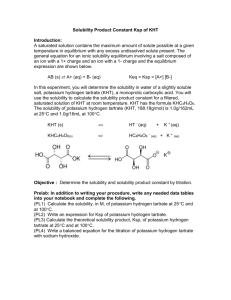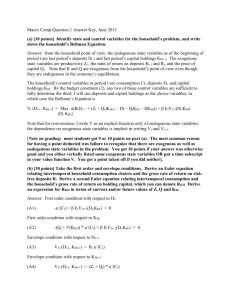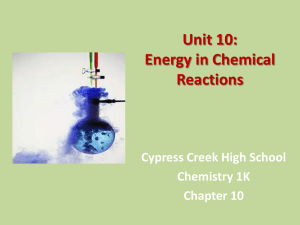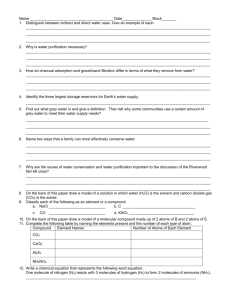The Common Ion Effect on Solubility
advertisement
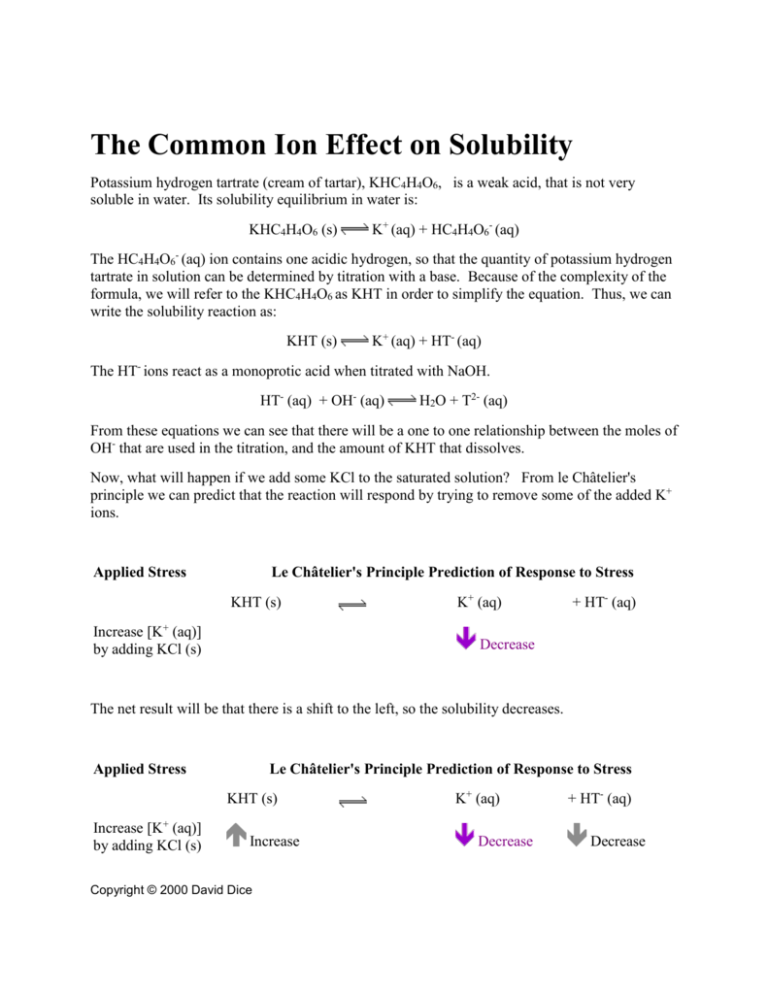
The Common Ion Effect on Solubility Potassium hydrogen tartrate (cream of tartar), KHC4H4O6, is a weak acid, that is not very soluble in water. Its solubility equilibrium in water is: KHC4H4O6 (s) K+ (aq) + HC4H4O6- (aq) The HC4H4O6- (aq) ion contains one acidic hydrogen, so that the quantity of potassium hydrogen tartrate in solution can be determined by titration with a base. Because of the complexity of the formula, we will refer to the KHC4H4O6 as KHT in order to simplify the equation. Thus, we can write the solubility reaction as: KHT (s) K+ (aq) + HT- (aq) The HT- ions react as a monoprotic acid when titrated with NaOH. HT- (aq) + OH- (aq) H2O + T2- (aq) From these equations we can see that there will be a one to one relationship between the moles of OH- that are used in the titration, and the amount of KHT that dissolves. Now, what will happen if we add some KCl to the saturated solution? From le Châtelier's principle we can predict that the reaction will respond by trying to remove some of the added K+ ions. Applied Stress Le Châtelier's Principle Prediction of Response to Stress KHT (s) Increase [K+ (aq)] by adding KCl (s) K+ (aq) + HT- (aq) Decrease The net result will be that there is a shift to the left, so the solubility decreases. Applied Stress Le Châtelier's Principle Prediction of Response to Stress KHT (s) Increase [K+ (aq)] by adding KCl (s) Increase Copyright © 2000 David Dice K+ (aq) Decrease + HT- (aq) Decrease The amount of additional KHT is too small to see; however, by measuring the actual amount of HT- by titration, we can find the quantitative change in solubility due to the added common ion, K+. Materials: buret 50 mL graduated cylinder about 150 mL of KCl solution (0.05, 0.10, 0.20 or 0.40 M, as assigned), or de-ionized water standardized solution of NaOH (approximately 0.0500 M) filter paper funnel Erlenmeyer flask 2 small beakers phenolphthalein indicator 2 500 ml PET soda bottles Procedures: Pure potassium hydrogen tartrate (KHT) is not dangerous; in fact, it is one of the ingredients in baking powder. However, in the lab it may be contaminated with other substances, so treat it as if it were dangerous. While the concentration of NaOH used in this experiment is not high, sodium hydroxide is extremely corrosive. Make sure to wear your safety goggles at all times. A lab apron is also a good idea to avoid staining your clothes. 1. Each person in each lab group will prepare a saturated solution of KHT in pure water, (0.0 M KCl) or an assigned concentration of KCl (from 0.05 to 0.4 M). Prepare the saturated solutions of KHT as follows (this will give you enough for two titrations – if you make a mistake you will have to prepare more solution): add about 1 g of KHT to the PET bottle put about 150 mL of water (or the assigned KCl solution) into the bottle cap, shake intensely and vigorously for at least 5 minutes 2. Fold a filter paper into halves, then into quarters. Place this filter paper into a dry funnel. Pour in some of your saturated solution of KHT, and filter about 10 mL into a clean graduated cylinder. The first few mL should be used to wash out the cylinder and thrown away. Then filter exactly 50 mL of the solution into the graduated cylinder, and pour it into the Erlenmeyer flask. Add one or two drops of phenolphthalein indicator. 3. Rinse the buret with a few mL of the standardized NaOH solution. Then fill the buret and measure the initial volume. Titrate the KHT solution to a permanent pink endpoint that lasts for at least 10 seconds. Copyright © 2000 David Dice 2 4. Repeat steps 2 and 3 with another 50 mL of KHT solution. You will now have two sets of data from which you can calculate the molar concentration of KHT in your assigned concentration of KCl. Conclusion: 1. Calculate the [HT-] from your titration data ([HT-] is the unknown concentration of the acid) for each trial. Calculate the average for the two trials. 2. Using the balanced equation, indicate why the [HT-] is the same as the solubility of KHT (s). 3. Tabulate the data for the entire class. Compare the solubility of KHT (s) as the concentration of K+ (aq) ions increases from the dissolved KCl. Explain your results. Extension: You can do the following using a calculator, but it is easier if you set up a spreadsheet to calculate the total concentration of K+ (aq) ions in each solution. To do this remember that there are two sources of K+ (aq): 1. from the dissolved KHT (so this [K+ (aq)] = [HT-] ) 2. from the dissolved KCl (so this [K+ (aq)] = [KCl] ) so that the [K+ (aq)]total = [HT-] + [KCl] Substitute this value of [K+ (aq)]total into the Ksp expression and calculate Ksp for each solution used (from pure water to 0.40 M KCl). Plot a graph of Ksp as a function of [K+ (aq)]total. Fit it to a linear graph, and extrapolate back to [K+ (aq)]total = 0. What is the value of Ksp at this point? You will notice when you do this that Ksp is not constant, but in fact changes with [K+ (aq)]total. This is because we have used concentrations to calculate the Ksp, and we should really use activities, which is a measure of how reactive a substance is. Only in very dilute solutions – as we extrapolate back to 0 concentration – does the activity equal the concentration. Activity and Its Effect on Solubility In order for an ion to dissolve in water it must cause some ordering or structure in the water molecules. This is because the positive ends of water molecules (the H atoms) are going to be attracted towards any negative ions, and the negative ends (the O atoms) to any positive ions. The greater the amount of ions present in the water, the more structured the water will be. This will make it easier for other ions to dissolve. This polarity effect enhances solubility, so in general, non-reacting ions cause an increase in activity (and thus in solubility) of ionic solids. The greater the concentration of ions, the more this effect takes place, and so the greater the activity of the ions becomes. Copyright © 2000 David Dice 3 So, for potassium hydrogen tartrate KHT (s) dissolving in water: KHT (s) K+ (aq) + HT-(aq) the equilibrium constant where is the activity of the K+ ions and is the activity of the HT ions. Since activity increases with increasing concentration, it is obvious that so does the Ksp Common ions of course are different, since they will take part in the reaction. A common ion will change the equilibrium as predicted by le Châtelier's principle. However, the common ion will always have a non-reacting oppositely charged “spectator” ion with it, so it too will have an impact on the activity. You can demonstrate this effect in the experiment to measure the solubility of potassium hydrogen tartrate (KHT). Simply add some NaCl (which has no ions in common with the KHT), and the solubility of the KHT will increase. The added ions increase the activity, therefore they cause the solubility product to increase. Copyright © 2000 David Dice 4
